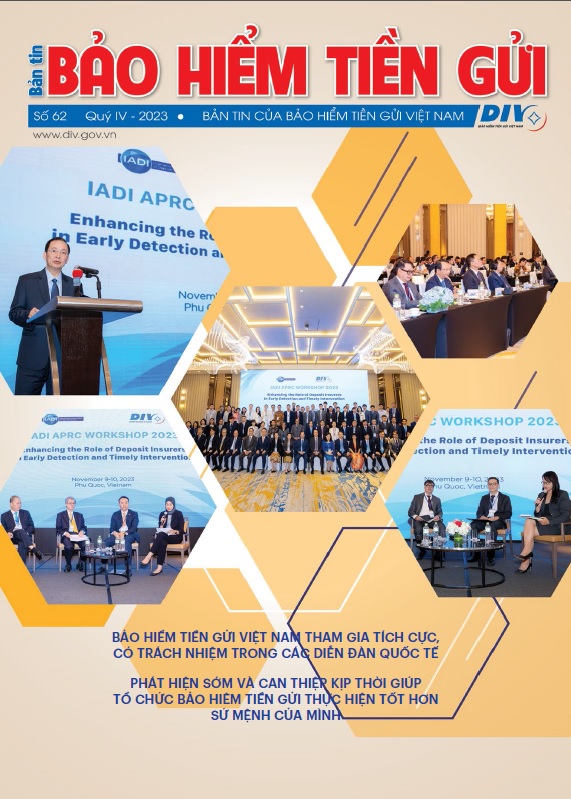Digital transformation in banking and deposit insuranceindustries
On May 11, 2021, the Governor of the State Bank of Vietnam (SBV) signed the Decision No. 810/QD-NHNN promulgating the plan for digital transformation of the banking sector by 2025 with orientations towards 2030. Under this plan, the banking industry must quickly develop and implement digital transformation by accelerating the application of new technologies;rendering the business model more streamlined and flexible; creating an organizational culture that adapts to the constant change, endless innovation and creativity;developing and providing productsand services driven by the customer-centric manner;re-equipping human resources with digital skills; building a digital culture for the workforce; attracting, retaining digital talents through a dynamic working environment and competitive remuneration policies.
For the banking system, thanks to having extensive access to technology, a digital transformation strategy has been developed and implemented in more favorable conditions. Banks have been taking steps to apply new technologies such as: Electronic Know Your Customer (eKYC), Artificial Intelligence (AI), Machine Learning (ML), Blockchain, Big Data, …, into their operations. Thanks to these technologies, the assessment and classification of customers have been done rapidly and flexibly; the administrative process has been simplified; and the length of transaction timehas been shortened. For example, in the present, many banks have allowed customers to open bank accounts completely online using mobile phone applications, instead of having to go to the counter like before.
For the people's credit fund (PCF) system, which has a smaller scale compared to other types of credit institution, financial and banking products and services for members are still a few. Therefore, the application of digital transformation is a challenge but also an important factor to help PCFs enhance the competitiveness in their operational areas and attract more customers. Determining on it, the PCF system has equipped itself with information technology (IT) infrastructure to fundamentally meet operational requirements. The level of IT and expertise of the staff of the PCFs have been focused right from recruitment and training in recent years. PCFs have applied software solutions to their operations, which are considered to be easy to use and suitable for the PCF system, contributing to effectively supporting their governance and administration, improving their operational quality and organizational images. Thanks to the IT system, PCFshavebeen on the right path to develop more strongly.
As one of the units in the banking industry, being well aware of the importance of digital transformation, a strategy has been being studied and carried out by the DIV. The first outcome is the development, implementation and completion of the Financial SectorModernization and Information Management System project (FSMIMS Project), DIV’s component. For DIV’s component, the FSMIMS project has been improving the operational effectiveness of the role of the deposit insurer in protecting depositors with the following results: (i) Enhancing information sharing, improvethe efficiency of information usageof the deposit insurer, between the deposit insurer and the central bank to ensure the safety and soundness of the banking system; (ii) Supporting the DIV in restructuring professionalactivities in accordance with international principles and standards as well as the provisions of law; a database system is established and shared throughout the DI system; modern software applications on DI operations are put into use; (iii) Supporting DIV in designing, purchasing and constructing modern technology architecture to fully meet operationalrequirements; (iv) Strengthening the internal governance capacity of the DIV to meet the development of the domestic banking system and comply with international standards. Besides, some professional activities of the DIV still keep innovating and applying IT to improve quality and meet the requirements of digital transformation such as calculation and collection of DI premiums, training, supervision and communication. Communication activities have been constantly expanded with more information channels and communication products have been improved in order to disseminateDI policies to people and areas, especially those in rural and remote areas. The training and developinghuman resources in the form of self-training and online training (E-learning) have been realized in the form of organizingcourses, examinations and the reports on the results of training courses in the online form, using QR code to access course materials, using online teaching applications. The calculation and collection of DI premiums has been also studied to improve efficiency; the integration of ICM - RL software, upgrading integration of RL - ERP software and performance of premium collection software have been approved by the DIV’s Initiative Council. The DIV is transforming itself and explicitly demonstrates its role and position in the global DI system in general and Vietnam's banking industry in particular.
Opportunities and challenges in digital transformation to change depositors' perceptions of deposit insurance
Catching up with the trend of digital transformation set by the SBV is both an opportunity and a challenge for the DIV’s Board of Directors in general and the DIV’s staff in particular. The application of new technologies such as eKYC, AI, Blockchain, Big Data… requires numerous investment resources and highly qualified human resources. The development of digital technology - besides its advantages - also leads to an increase in security holes that are easily exploited by high-tech criminals and hackers. Therefore, the off-site examination and supervision needs to be invested more in infrastructure, high security mechanisms, multi-layer prevention mechanisms to prevent attacks, and in applying new defense schemes at the same time. In addition, a number of legal issues and technical standards need to be resolved such as: The synchronization and relevance of current legal regulations related to electronic transactions, signatures, electronic documents; the data sharing and information security; business processes with the practical application of digital technology in banking activities; the synchronization and standardization of technical infrastructure to facilitate interconnection and seamless integration between the banking industry and other industries and fields to form a digital ecosystem and provide multi-utility services for depositors.
Recently, the DIVhas attended a training course on Digital Transformation in Banking organized by the SBV and the GIZ Project (Germany) and trainedits staff to acquire knowledge about digital payment system and cryptocurrencies,digitalization in lending operations, open banking and banking ecosystem in the digital era, cybersecurity and banking supervision in the digitalized context. In order to catch up with the trend of digital transformation, the DIV needs to continue to innovate more in professional activities to meet the requirements and context of digitalization; deploy communication channels easily accessible to people/depositors, for example, launch more hotlines and automatic reply box system (Chatbot) using AI or Big Data; use social networks for information dissemination (such as Youtube, Facebook...); build a portal or a smartphone application separately designed for DIV’s staff; Integrating information about the DIV into other banking applications of the banking system participating in DI (in the section on depositor policies); Organize contests in the form of online gameshows on DI policies, participants can be young people, pupils and students across the country. Some basic training courses in the future, instead of being organized on-site, can be changed by composing an electronic lesson plans, providing a separate account with studying time limit, so that students can actively sign in. The purpose of these innovations is to build a separate ecosystem for the DIV, but in the long term, it is necessary to expand into a common model for the whole DI system in the world. Finally, these policies should aim to create favorable environment that promotes the development of digital banking through creating a fair and competitive environment, encouraging innovations and protecting depositors.
In order to successfully implement these policies, the DIV needs to recommend to the SBV to continue improvingpolicy mechanisms and legal frameworks in banking activities to adapt to Industrial Revolution 4.0, to assign specific tasks to the DIV, to facilitate and promote the digital transformation, develop the banking system in general and DI activities in particular, while focusing on ensuring network security and protecting the interests of depositors.
At the same time, the DIV continues to organize training courses, seminars and conferences to train and foster the staff to have better access to the knowledge of modern digital transformation; implement digital transformation solutions towards the goal of financial inclusion; strengthen communication activities, financial education and raise the awareness and knowledge of depositors about DI activities.



























